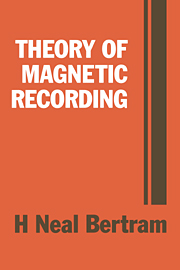Book contents
- Frontmatter
- Contents
- Preface
- 1 Overview
- 2 Review of magnetostatic fields
- 3 Inductive head fields
- 4 Medium magnetic fields
- 5 Playback process: Part 1 – General concepts and single transitions
- 6 Playback process: Part 2 – Multiple transitions
- 7 Magnetoresistive heads
- 8 Record process: Part 1 – Transition models
- 9 Record process: Part 2 – Non-linearities and overwrite
- 10 Medium noise mechanisms: Part 1 – General concepts, modulation noise
- 11 Medium noise mechanisms: Part 2 – Particulate noise
- 12 Medium noise mechanisms: Part 3 – Transition noise
- References and bibliography
- Index
6 - Playback process: Part 2 – Multiple transitions
Published online by Cambridge University Press: 02 February 2010
- Frontmatter
- Contents
- Preface
- 1 Overview
- 2 Review of magnetostatic fields
- 3 Inductive head fields
- 4 Medium magnetic fields
- 5 Playback process: Part 1 – General concepts and single transitions
- 6 Playback process: Part 2 – Multiple transitions
- 7 Magnetoresistive heads
- 8 Record process: Part 1 – Transition models
- 9 Record process: Part 2 – Non-linearities and overwrite
- 10 Medium noise mechanisms: Part 1 – General concepts, modulation noise
- 11 Medium noise mechanisms: Part 2 – Particulate noise
- 12 Medium noise mechanisms: Part 3 – Transition noise
- References and bibliography
- Index
Summary
Introduction
In this chapter analysis of the playback process is extended to consider the effects of multiple transitions. First the concept of linear superposition in magnetic recording is introduced. Two examples are discussed in detail: (1) square wave recording of alternating transitions with a fixed bit spacing and (2) dibit recording of a pair of transitions. In the former both the ‘roll-off’ curve of the peak voltage versus density will be derived as well as the spectrum or Fourier transform. The utility of spectral measurements for analysis of the recording process will be emphasized as in Chapter 5. The relation of the square wave spectrum to an ‘effective’ channel transfer function will be given. In this chapter, as in the previous one, a comparison will be made between longitudinal and perpendicular recording. The effects that relate solely to differences in a change in magnetization orientation will be emphasized. In this way the playback effects and record phenomena discussed in Chapter 8 can be distinguished.
Linear superposition
The magnetic recording process is not strictly linear. A linear integral relation does not occur where a change in input amplitude yields a proportional change in output voltage. In fact an impulse does not exist because the ‘input’ to the recording channel consists of step functions of voltage or current that produce transitions of magnetization. However, a restricted linearity applies as long as transitions are not written too closely. A transfer function can be defined whose product with the input spectrum yields the output spectrum.
- Type
- Chapter
- Information
- Theory of Magnetic Recording , pp. 139 - 165Publisher: Cambridge University PressPrint publication year: 1994



